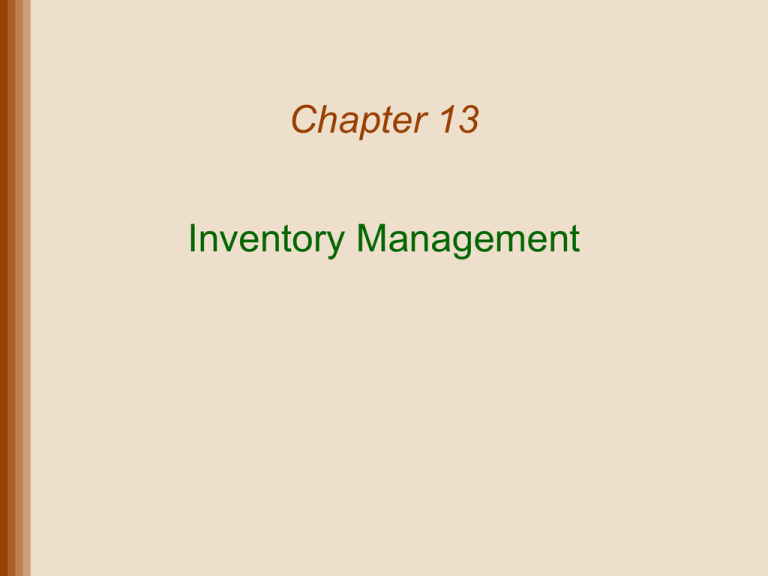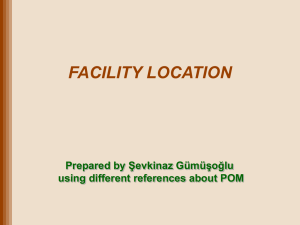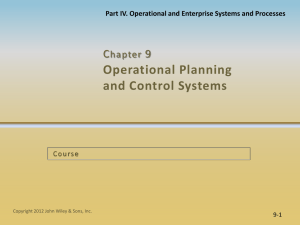
Chapter 13
Inventory Management
Lecture Outline
•
•
•
•
•
•
Elements of Inventory Management
Inventory Control Systems
Economic Order Quantity Models
Quantity Discounts
Reorder Point
Order Quantity for a Periodic Inventory System
Copyright 2011 John Wiley & Sons, Inc.
13-2
What Is Inventory?
• Stock of items kept to meet future demand
• Purpose of inventory management
• how many units to order
• when to order
Copyright 2011 John Wiley & Sons, Inc.
13-3
Supply Chain Management
• Bullwhip effect
• demand information is distorted as it moves away
from the end-use customer
• higher safety stock inventories to are stored to
compensate
•
•
•
•
Seasonal or cyclical demand
Inventory provides independence from vendors
Take advantage of price discounts
Inventory provides independence between
stages and avoids work stoppages
Copyright 2011 John Wiley & Sons, Inc.
13-4
Quality Management in the Supply Chain
• Customers usually perceive quality service as
availability of goods they want when they want
them
• Inventory must be sufficient to provide highquality customer service in QM
Copyright 2011 John Wiley & Sons, Inc.
13-5
Types of Inventory
• Raw materials
• Purchased parts and supplies
• Work-in-process (partially completed) products
(WIP)
• Items being transported
• Tools and equipment
Copyright 2011 John Wiley & Sons, Inc.
13-6
Two Forms of Demand
• Dependent
• Demand for items used to produce final
products
• Tires for autos are a dependent demand item
• Independent
• Demand for items used by external customers
• Cars, appliances, computers, and houses are
examples of independent demand inventory
Copyright 2011 John Wiley & Sons, Inc.
13-7
Inventory Costs
• Carrying cost
• cost of holding an item in inventory
• Ordering cost
• cost of replenishing inventory
• Shortage cost
• temporary or permanent loss of sales when
demand cannot be met
Copyright 2011 John Wiley & Sons, Inc.
13-8
Inventory Control Systems
• Continuous system (fixed-order-quantity)
• constant amount ordered when inventory declines to
predetermined level
• Periodic system (fixed-time-period)
• order placed for variable amount after fixed passage
of time
Copyright 2011 John Wiley & Sons, Inc.
13-9
ABC Classification
• Class A
• 5 – 15 % of units
• 70 – 80 % of value
• Class B
• 30 % of units
• 15 % of value
• Class C
• 50 – 60 % of units
• 5 – 10 % of value
Copyright 2011 John Wiley & Sons, Inc.
13-10
ABC Classification
PART
UNIT COST
ANNUAL USAGE
1
2
3
4
5
6
7
8
9
10
$ 60
350
30
80
30
20
10
320
510
20
90
40
130
60
100
180
170
50
60
120
Copyright 2011 John Wiley & Sons, Inc.
13-11
ABC Classification
PART
9
8
2
1
4
3
6
5
10
7
TOTAL
VALUE
% OF TOTAL
VALUE
$30,600
16,000
14,000
5,400
4,800
3,900
3,600
3,000
2,400
1,700
$85,400
35.9
18.7
16.4
6.3
5.6
4.6
4.2
3.5
2.8
2.0
% OF TOTAL
QUANTITY
6.0
5.0
4.0
9.0
6.0
10.0
18.0
13.0
12.0
17.0
% CUMMULATIVE
A
B
C
6.0
11.0
15.0
24.0
30.0
40.0
58.0
71.0
83.0
100.0
Example 10.1
Copyright 2011 John Wiley & Sons, Inc.
13-12
ABC Classification
CLASS
A
B
C
ITEMS
9, 8, 2
1, 4, 3
6, 5, 10, 7
% OF TOTAL
VALUE
% OF TOTAL
QUANTITY
71.0
16.5
12.5
15.0
25.0
60.0
Example 10.1
Copyright 2011 John Wiley & Sons, Inc.
13-13
Economic Order Quantity
(EOQ) Models
• EOQ
• optimal order quantity that will minimize
total inventory costs
• Basic EOQ model
• Production quantity model
Copyright 2011 John Wiley & Sons, Inc.
13-14
Assumptions of Basic EOQ Model
• Demand is known with certainty and is constant
over time
• No shortages are allowed
• Lead time for the receipt of orders is constant
• Order quantity is received all at once
Copyright 2011 John Wiley & Sons, Inc.
13-15
Inventory Order Cycle
Inventory Level
Order quantity, Q
Demand
rate
Average
inventory
Q
2
Reorder point, R
0
Copyright 2011 John Wiley & Sons, Inc.
Lead
time
Order Order
placed receipt
Lead
time
Order Order
placed receipt
Time
13-16
EOQ Cost Model
Co - cost of placing order
Cc - annual per-unit carrying cost
D - annual demand
Q - order quantity
Annual ordering cost =
CoD
Q
Annual carrying cost =
CcQ
2
Total cost =
Copyright 2011 John Wiley & Sons, Inc.
CoD
+
Q
CcQ
2
13-17
EOQ Cost Model
Proving equality of
costs at optimal point
Deriving Qopt
CoD
CcQ
TC =
+
Q
2
Co D
Cc
TC
= – Q2 +
2
Q
C0D
Cc
0 = – Q2 +
2
Qopt =
2CoD
Cc
Copyright 2011 John Wiley & Sons, Inc.
CoD
CcQ
=
Q
2
Q2
2CoD
=
Cc
Qopt =
2CoD
Cc
13-18
EOQ Cost Model
Annual
cost ($)
Total Cost
Slope = 0
CcQ
Carrying Cost =
2
Minimum
total cost
CoD
Ordering Cost = Q
Optimal order
Qopt
Copyright 2011 John Wiley & Sons, Inc.
Order Quantity, Q
13-19
EOQ Example
Cc = $0.75 per gallon
Qopt =
2CoD
Cc
Qopt =
2(150)(10,000)
(0.75)
Co = $150
Qopt = 2,000 gallons
Orders per year = D/Qopt
= 10,000/2,000
= 5 orders/year
Copyright 2011 John Wiley & Sons, Inc.
D = 10,000 gallons
CoD
CcQ
TCmin =
+
Q
2
TCmin
(150)(10,000) (0.75)(2,000)
=
+
2,000
2
TCmin = $750 + $750 = $1,500
Order cycle time = 311 days/(D/Qopt)
= 311/5
= 62.2 store days
13-20
Production Quantity Model
• Order is received gradually, as inventory is
simultaneously being depleted
• AKA non-instantaneous receipt model
• assumption that Q is received all at once is relaxed
• p - daily rate at which an order is received over
time, a.k.a. production rate
• d - daily rate at which inventory is demanded
Copyright 2011 John Wiley & Sons, Inc.
13-21
Production Quantity Model
Inventory
level
Q(1-d/p)
Maximum
inventory
level
Q
(1-d/p)
2
Average
inventory
level
0
Order
receipt period
Begin
End
order order
receipt receipt
Copyright 2011 John Wiley & Sons, Inc.
Time
13-22
Production Quantity Model
p = production rate
d = demand rate
Maximum inventory level = Q - Q d
p
=Q1- d
p
Average inventory level =
Q
12
d
p
2CoD
Qopt =
d
Cc 1 p
CoD CcQ
d
TC = Q + 2 1 - p
Copyright 2011 John Wiley & Sons, Inc.
13-23
Production Quantity Model
Cc = $0.75 per gallon
Co = $150
d = 10,000/311 = 32.2 gallons per day
2CoD
Qopt =
Cc 1 - d
p
D = 10,000 gallons
p = 150 gallons per day
2(150)(10,000)
=
CoD CcQ
d
TC = Q + 2 1 - p
32.2
0.75 1 150
= 2,256.8 gallons
= $1,329
2,256.8
Q
Production run =
=
= 15.05 days per order
150
p
Copyright 2011 John Wiley & Sons, Inc.
13-24
Production Quantity Model
Number of production runs =
10,000
D
=
= 4.43 runs/year
2,256.8
Q
Maximum inventory level = Q 1 -
d
p
= 2,256.8 1 -
32.2
150
= 1,772 gallons
Copyright 2011 John Wiley & Sons, Inc.
13-25
Solution of EOQ Models With Excel
The optimal order
size, Q, in cell D8
Copyright 2011 John Wiley & Sons, Inc.
13-26
Solution of EOQ Models With Excel
The formula for Q
in cell D10
=(D4*D5/D10)+(D3*D10/2)*(1-(D7/D8))
=D10*(1-(D7/D8))
Copyright 2011 John Wiley & Sons, Inc.
13-27
Solution of EOQ Models With OM Tools
Copyright 2011 John Wiley & Sons, Inc.
13-28
Quantity Discounts
Price per unit decreases as order
quantity increases
CoD
CcQ
TC =
+
+ PD
Q
2
where
P = per unit price of the item
D = annual demand
Copyright 2011 John Wiley & Sons, Inc.
13-29
Quantity Discount Model
ORDER SIZE
0 - 99
100 – 199
200+
PRICE
$10
8 (d1)
6 (d2)
TC = ($10 )
TC (d1 = $8 )
Inventory cost ($)
TC (d2 = $6 )
Carrying cost
Ordering cost
Q(d1 ) = 100 Qopt
Copyright 2011 John Wiley & Sons, Inc.
Q(d2 ) = 200
13-30
Quantity Discount
QUANTITY
1 - 49
50 - 89
90+
Qopt =
PRICE
$1,400
1,100
900
2CoD
=
Cc
Co = $2,500
Cc = $190 per TV
D = 200 TVs per year
2(2500)(200)
= 72.5 TVs
190
For Q = 72.5
CcQopt
CoD
TC =
+
2 + PD = $233,784
Qopt
For Q = 90
CcQ
CoD
TC =
+ 2 + PD = $194,105
Q
Copyright 2011 John Wiley & Sons, Inc.
13-31
Quantity Discount Model With Excel
=IF(D10>B10,D10,B10)
Copyright 2011 John Wiley & Sons, Inc.
=(D4*D5/E10)+(D3*E10/2)+C10*D5
13-32
Reorder Point
•
Inventory level at which a new order is placed
R = dL
where
d = demand rate per period
L = lead time
Copyright 2011 John Wiley & Sons, Inc.
13-33
Reorder Point
Demand = 10,000 gallons/year
Store open 311 days/year
Daily demand = 10,000 / 311 = 32.154
gallons/day
Lead time = L = 10 days
R = dL = (32.154)(10) = 321.54 gallons
Copyright 2011 John Wiley & Sons, Inc.
13-34
Safety Stock
• Safety stock
• buffer added to on hand inventory during lead time
• Stockout
• an inventory shortage
• Service level
• probability that the inventory available during lead
time will meet demand
• P(Demand during lead time <= Reorder Point)
Copyright 2011 John Wiley & Sons, Inc.
13-35
Inventory level
Variable Demand With Reorder Point
Q
Reorder
point, R
0
LT
LT
Time
Copyright 2011 John Wiley & Sons, Inc.
13-36
Inventory level
Reorder Point With Safety Stock
Q
Reorder
point, R
Safety Stock
0
LT
Copyright 2011 John Wiley & Sons, Inc.
Time
LT
13-37
Reorder Point With Variable Demand
R = dL + zd L
where
d = average daily demand
L = lead time
d = the standard deviation of daily demand
z = number of standard deviations
corresponding to the service level
probability
zd L = safety stock
Copyright 2011 John Wiley & Sons, Inc.
13-38
Reorder Point For a Service Level
Probability of
meeting demand during
lead time = service level
Probability of
a stockout
Safety stock
zd L
dL
Demand
Copyright 2011 John Wiley & Sons, Inc.
R
13-39
Reorder Point For Variable Demand
The paint store wants a reorder point with a 95%
service level and a 5% stockout probability
d = 30 gallons per day
L = 10 days
d = 5 gallons per day
For a 95% service level, z = 1.65
R = dL + z d L
Safety stock = z d L
= 30(10) + (1.65)(5)( 10)
= (1.65)(5)( 10)
= 326.1 gallons
= 26.1 gallons
Copyright 2011 John Wiley & Sons, Inc.
13-40
Determining Reorder Point with Excel
The reorder point
formula in cell E7
Copyright 2011 John Wiley & Sons, Inc.
13-41
Order Quantity for a
Periodic Inventory System
Q = d(tb + L) + zd
tb + L - I
where
d
tb
L
d
zd
= average demand rate
= the fixed time between orders
= lead time
= standard deviation of demand
tb + L = safety stock
I = inventory level
Copyright 2011 John Wiley & Sons, Inc.
13-42
Periodic Inventory System
Copyright 2011 John Wiley & Sons, Inc.
13-43
Fixed-Period Model With
Variable Demand
d
d
tb
L
I
z
= 6 packages per day
= 1.2 packages
= 60 days
= 5 days
= 8 packages
= 1.65 (for a 95% service level)
Q = d(tb + L) + zd
tb + L - I
= (6)(60 + 5) + (1.65)(1.2)
60 + 5 - 8
= 397.96 packages
Copyright 2011 John Wiley & Sons, Inc.
13-44
Fixed-Period Model with Excel
Formula for order
size, Q, in cell D10
Copyright 2011 John Wiley & Sons, Inc.
13-45
Copyright 2011 John Wiley & Sons, Inc.
All rights reserved. Reproduction or translation of this
work beyond that permitted in section 117 of the 1976
United States Copyright Act without express permission
of the copyright owner is unlawful. Request for further
information should be addressed to the Permission
Department, John Wiley & Sons, Inc. The purchaser
may make back-up copies for his/her own use only and
not for distribution or resale. The Publisher assumes no
responsibility for errors, omissions, or damages caused
by the use of these programs or from the use of the
information herein.
Copyright 2011 John Wiley & Sons, Inc.
13-46









